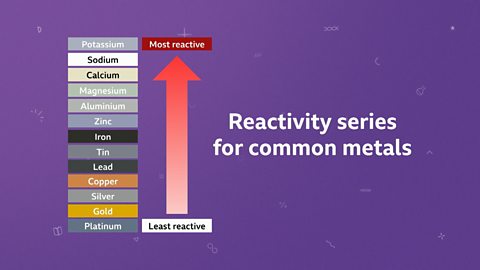Key Points
- Symbol equations are a quick way of representing chemical reactions. They show us what atoms are involved and how they are bonded together.
- Symbol equations always take the form, reactants → products. A + sign separates two or more reactants or products.
- State symbols are used in symbol equations to show whether each chemical is a solid, liquid, gas or solution.
In a symbol equation, what symbol is used to show a chemical reaction has taken place?
An arrow → is used.
This goes between the reactants on the left and the products on the right.
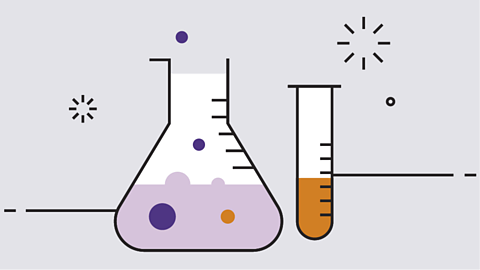
Video
Watch this video to find out more about how symbol equations are used to represent and summarise chemical reactionWhen chemical bonds are broken and made between atoms, so that new substances (compounds or elements) are made..
While you're watching, look out for the size of the numbers used in the chemical formulaePlural of formula..
Chemical reactions can be pretty exciting!
But it’s often hard to know exactly what’s going on.
We can use word equations to represent the reaction, showing which reactants are involved, and what products are produced.
Sometimes it’s useful to know more detail about the substances involved in the reaction. Like how much of each reactant is needed, and the ratio of atoms in the product.
For that, we can turn our word equation into a symbol equation, like this one. It uses chemical symbols from the periodic table to represent the elements involved. Iron is Fe and oxygen is O. When it’s in the air, oxygen is two atoms joined together, so it’s represented by O2.
So iron, Fe, reacts with oxygen in the air, O2, to make iron oxide: Fe2O3.
Let’s try it with another reaction.
When solid magnesium reacts with sulfuric acid solution, it fizzes as a gas is produced.The products are hydrogen gas, and the salt magnesium sulfate.
The symbol for magnesium is Mg, and sulfuric acid is a compound containing sulfur, oxygen, and hydrogen. Its formula is written: H2SO4. So we write Mg plus H2SO4.
An arrow shows the direction of the reaction, just like in a word equation. Then the product hydrogen is written as H2, and the magnesium sulphate is MgSO4. That’s our symbol equation.
If you look carefully you can see that there are the same number of each element on both sides of the equation. There’s one magnesium, two hydrogen, one sulfur, and four oxygen. And state symbols in the brackets show which substances are solid, liquid, gases, or dissolved solution. The ‘aq’ tells us that magnesium sulfate is dissolved in water.
All you could ever want to know about your favourite chemical reactions!
What did you notice about the size of the numbers used in the formulae?
The numbers are small and slightly lower than the letters. We call these kinds of numbers subscripts.
For example, the formula for oxygen is O₂, and sulfuric acid is H₂SO₄.
Formulae for compounds and elements
Chemical symbols and formulae are used to represent elementA pure substance which is made from only one type of atom. Elements are listed on the periodic table. and compoundA pure substance made from two or more elements which are chemically bonded in a fixed ratio. , for example:
- H₂ is the formulaA formula is made up of the symbols for one or more element and a subscripted number to show how many atoms of each element are bonded together. of hydrogen
- H₂SO₄ is the formula of sulfuric acid
- Mg is the symbol of magnesium, this is a symbol and not a formula because there are no numbers
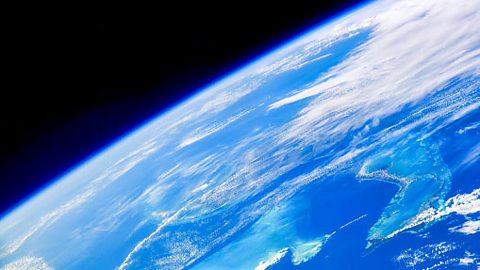
Chemical formulae are used to show how many of each type of atomThe smallest particle of an element. We often think of atoms as tiny spheres, but in fact they are made from smaller particles called protons, neutrons and electrons. is chemically bonded together within a substance. For example, the formula for water is H₂O which shows that each moleculeTwo or more atoms which are strongly bonded together. The smallest particle of a substance that has all of the physical and chemical properties of that substance. is made from two hydrogen atoms bonded to one oxygen atom.
Some non-metalA substance that has the typical properties of a non-metal. Non-metal elements are on the right hand side of the periodic table. elements are made from molecules. For example, hydrogen has a chemical formula of H₂, and oxygen is O₂. The little numbers are called subscriptSubscripted numbers are used to show how many atoms are chemically bonded together in a compound (or a molecule of an element). The subscripted numbers are smaller than a regular number, and written lower down. For example, the formula H₂O contains a subscripted number 2. This tells you that there are 2 hydrogen atoms for every 1 oxygen atom. and show how many atoms of that element are present.
Other non-metal elements and all metalA substance which has the typical properties of a metal. Metals are found to the left and in the middle of the periodic table. elements are represented by just their symbol. For example, magnesium is Mg and carbon is C.

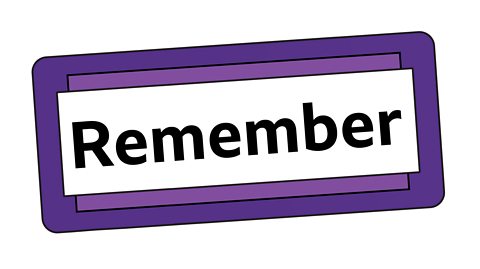
The word formulae is the plural of the word formula. If we're talking about more than one formula, we usually say formulae.
The formula of ammonia is NH₃. How many nitrogen (N) and hydrogen (H) atoms are present in the molecule?
Each ammonia molecule contains one atom of nitrogen and three atoms of hydrogen.
We know this because the hydrogen symbol has a subscript three after it, whereas the nitrogen symbol has no number meaning there’s only one.
Writing a symbol equation
Chemical reactions can be represented using symbol equations. In a symbol equation, substances are written using their chemical symbol or formula.
- The formulae of the reactantThe chemical present at the start of a reaction. Reactants appear on the left of a chemical equation, before the arrow →. always go first in a symbol equation. The reactants are separated using a + symbol.
- After the reactants, there is an arrow → to show that the chemical reaction has taken place.
- The productA chemical which is made in a chemical reaction. Products are written on the right of a chemical equation, after the arrow (→). are written after the arrow and are also separated by + symbols.
Example
When carbon © is burned in air, the carbon reacts with oxygen (O₂) and carbon dioxide (CO₂) is produced.
The symbol equation for this reaction is:
C + O₂ → CO₂
Compare this to the word equation:
Carbon + oxygen → carbon dioxide

A symbol equation should only contain symbols and formulae for the chemicals.
Don’t use the names of the chemicals in a symbol equation. We only use the names of chemicals in word equations. Find out more about word equations in this guide.
Test your knowledge of the different symbols used in chemical equations in this quiz.
Quiz - What am I?
When iron (Fe) is heated, it reacts with sulfur (S) to produce iron sulfide (FeS).
What is the symbol equation for this reaction?
The symbol equation is:
Fe + S → FeS
Compare this to the word equation:
Iron + sulfur → iron sulfide

Using state symbols
state symbolAn abbreviation used in brackets in a chemical equation to show whether a substance is a solid (s), liquid (l), gas (g) or dissolved in water (aq). are used in symbol equations to show what state – solid, liquid, gas or solutionA mixture made when a solute (usually a solid) dissolves into a solvent (a liquid). Sea water is a solution of salt dissolved into water. – each substance is in.
| State | State symbol |
|---|---|
| Solid | (s) |
| Liquid | (l) |
| Gas | (g) |
| Aqueous solution | (aq) |
State symbols are written after the formula of each substance.
For example, compare the word equation below with its symbol equation.
Magnesium carbonate + sulfuric acid → magnesium sulfate + water + carbon dioxide
MgCO₃(s) + H₂SO₄(aq) → MgSO₄(aq) + H₂O(l) + CO₂(g)
The symbol equation shows that solid magnesium carbonate reacts with a solution of sulfuric acid to produce a solution of magnesium sulfate, plus liquid water and some carbon dioxide gas.
Summarise the following reaction with a symbol equation, including state symbols.
Liquid hexane (C₆H₁₄) reacts with oxygen gas (O₂). The products are carbon dioxide gas (CO₂) and liquid water (H₂O).
The symbol equation is:
C₆H₁₄(l) + O₂(g) → CO₂(g) + H₂O(l)
Compare this to the word equation:
Hexane + oxygen → carbon dioxide + water
Test your knowledge
Quiz
GCSE exam dates 2025
Find out everything you need to know about the 2025 GCSE exams including dates, timetables and changes to exams to get your revision in shape.

More on Chemical reactions
Find out more by working through a topic
- count7 of 12
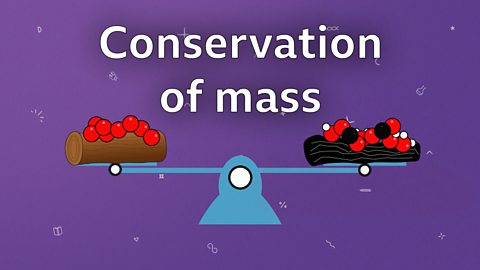
- count8 of 12
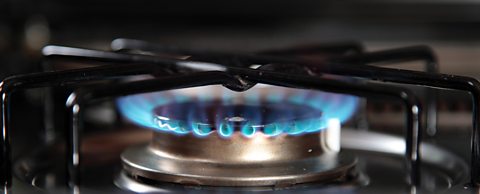
- count9 of 12
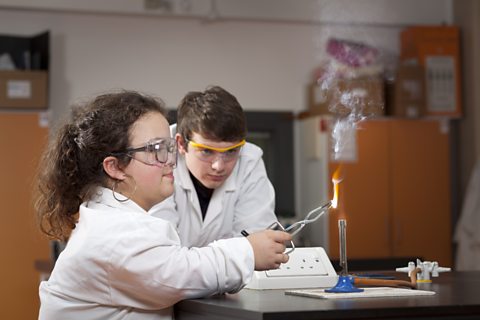
- count10 of 12
